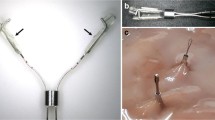Abstract
Purpose
We investigated the feasibility of a fluorescence imaging technique using light-emitting diode (LED)-activated indocyanine green (ICG) fluorescence.
Methods
Indocyanine green injections were given to patients undergoing preoperative colonoscopy for early colon cancer or colon adenoma. During subsequent laparotomy, the colon was first observed with the naked eye, and then using a prototype machine with a charge-coupled device (CCD) video camera equipped with a cutoff filter and a LED at a wavelength of 760 nm as the light source.
Results
LED-induced fluorescence showed tumor localization clearly and accurately in all ten patients (100%) enrolled in this study, whereas it was seen with the naked eye as a green spot in only two patients (20%) (P = 0.0077; Wilcoxon’s signed-rank test). There were no complications of LED-induced fluorescence and no inflammatory signs were noted on the hematoxylin-eosin-stained slides for the identified injection sites in the resected specimens.
Conclusions
Colonic tattooing using this fluorescence imaging technique of LED-activated ICG fluorescence is a new concept of colonic marking based on the characteristics that ICG is a near infrared fluorescent dye, and is useful, without any adverse effects, to identify perioperatively the tumor localization.
Similar content being viewed by others
References
Choi YS, Lee SI, Lee TG, Kim SW, Cheon G, Kang SB. Economic outcomes of laparoscopic versus open surgery for colorectal cancer in Korea. Surg Today 2007;37:127–132.
Ponsky JL, King JF. Endoscopic marking of colonic lesions. Gastrointest Endosc 1975;22:42–47.
Coman E, Brandt LJ, Brenner S, Frank M, Sablay B, Bennett B. Fat necrosis and inflammatory pseudotumor due to endoscopic tattooing of the colon with India ink. Gastrointest Endosc 1991;37:65–68.
Gianom D, Hollinger A, Wirth HP. Intestinal perforation after preoperative colonic tattooing with India ink. Swiss Surg 2003;9:307–310.
Botoman VA, Pietro M, Thirlby RC. Localization of colonic lesions with endoscopic tattoo. Dis Colon Rectum 1994;37:775–776.
Bahadursingh AM, Driver M, Koenig CL, Longo WE. Inadvertent transmural India ink tattooing simulating intestinal infarction. Am J Surg 2003;185:88–89.
Yano H, Okada K, Monden T. Adhesion ileus caused by tattoo-marking: unusual complication after laparoscopic surgery for early colorectal cancer. Dis Colon Rectum 2003;46:987.
Kusano M, Tajima Y, Yamazaki K, Kato M, Watanabe M, Miwa M. Sentinel node mapping guided by indocyanine green fluorescence imaging: a new method for sentinel node navigation surgery in gastrointestinal cancer. Dig Surg 2008;25:103–108.
Price N, Gottfried MR, Clary E, Lawson DC, Baillie J, Mergener K, et al. Safety and efficacy of India ink and indocyanine green as colonic tattooing agents. Gastrointest Endosc 2000;51:438–442.
Lane KL, Vallera R, Washington K, Gottfried MR. Endoscopic tattoo agents in the colon; tissue responses and clinical implications. Am J Surg Pathol 1996;20:1266–1270.
Hammond DC, Lane FR, Welk RA, Madura MJ, Borreson DK, Passinault WJ. Endoscopic tattooing of the colon. An experimental study. Am Surg 1989;55:457–461.
Lee JG, Low AH, Leung JW. Randomized comparative study of indocyanine green and India ink for colonic tattooing. An animal survival study. J Clin Gastroenterol 2000;31:233–236.
Hellmig S, Stüber E, Kiehne K, Kosmahl M, Fölsch U. What do we really know about the long-term safety of colonic tattooing? Gastrointest Endosc 2005;61:186–187.
Kitai T, Inomoto T, Miwa M, Shikayama T. Fluorescence navigation with indocyanine green for detecting sentinel lymph nodes in breast cancer. Breast Cancer 2005;12:211–215.
Taggart DP, Choudhary B, Anastasiadis K, Abu-Omar Y, Balacumaraswami L, Pigott DW. Preliminary experience with a novel intraoperative fluorescence imaging technique to evaluate the patency of bypass grafts in total arterial revascularization. Ann Thorac Surg 2003;75:870–873.
Bilchik AJ Trocha SD. Lymphatic mapping and sentinel node analysis to optimize laparoscopic resection and staging of colorectal cancer: an update. Cancer Control 2003;10:219–223.
Author information
Authors and Affiliations
Rights and permissions
About this article
Cite this article
Watanabe, M., Tsunoda, A., Narita, K. et al. Colonic tattooing using fluorescence imaging with light-emitting diode-activated indocyanine green: A feasibility study. Surg Today 39, 214–218 (2009). https://doi.org/10.1007/s00595-008-3849-9
Received:
Accepted:
Published:
Issue Date:
DOI: https://doi.org/10.1007/s00595-008-3849-9




